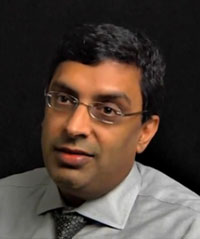
Projects Funded
3-D Cardiac Tissue Engineering: Using Decellularized Scaffolds For Engineering Whole Heart (2009-2010)
Principal Investigator

Sunjay Kaushal, MD, PHD
Children’s Memorial Hospital, Chicago
Project Summary
Bioartificial Engineering of Hearts Using Decellularized Extracellular Matrix:
Hearts disease is a global killer – with over 22 million people affected worldwide. In the United States, 36,000 children are born annually with congenital heart defects – approximately 1/100 live births. Current treatment options for children with severe cardiac defects and those with CHF include medical therapy, cardiac pacing, mechanical ventricular assist device implantation (VAD), and heart replacement. Unfortunately for children in need of heart (or valve) transplantation, there are small numbers of donor hearts available. Between 1997 and 2006, twenty-four percent of children less than 1 year of age died waiting for a donor heart to become available. Since 1999, the average wait time on the transplant list is 83 days for children less than 5 years of age. Unfortunately, many infants and children on the transplantation list die without receiving a transplant. Bioartificially-engineered whole organs or heart chambers may be a feasible solution to the lack of donor organs.
We propose to use whole-organ decellularization to generate extracellular matrices of human-size tissues as a starting point for bioartificial organogensis. The specific hypothesis of this proposed research is that the underlying extracellular matrix (ECM) of heart tissue retains its structural geometry and native vasculature. In this way, it will provide a scaffold for stem cells and will both 1) allow for cell differentiation into organized, contractile tissue over time, and 2) nourish cellular environments via its retained native vascular conduits – together enabling the bioengineering of functional, human-sized whole heart in vitro.
We will use a perfusion bioreactor to simulate physiological conditions in the ECM, onto which we will seed uncommitted progenitors, cardiac precursors, and/or bone marrow-derived mesenchymal stem cells. We will measure left ventricular (LV) end-systolic and end-diastolic pressures/volumes, levels of pre and afterload, and the electrical response of the heart after establishing physiologic conditions in vitro. Finally, we will transplant the recellularized constructs into isogeneic animals, and evaluate for left ventricular pressure, ejection fraction, central and peripheral pressures, graft perfusion and bleeding of the neomyocardial LV hetero graft. Completion of this study will address the feasibility of recellularizing perfusion decellularized whole-hearts in animals which are scalable to human-size. Our study, additionally, will address questions relating to the retention of desired physiologic properties.
Specific Aims
This project will be investigated in three Specific Aims. In brief, Specific Aim-1 will investigate the establishment of the starting material: an extracellular matrix from swine cadaver. Specific Aim-2 outlines the plan for in vitro “recellularization” of the constructs obtained in Aim1. Specific Aim-3 describes the plans to transplant the bioartificial hearts from Aim2, and study their properties in vivo.
View All Projects
